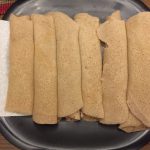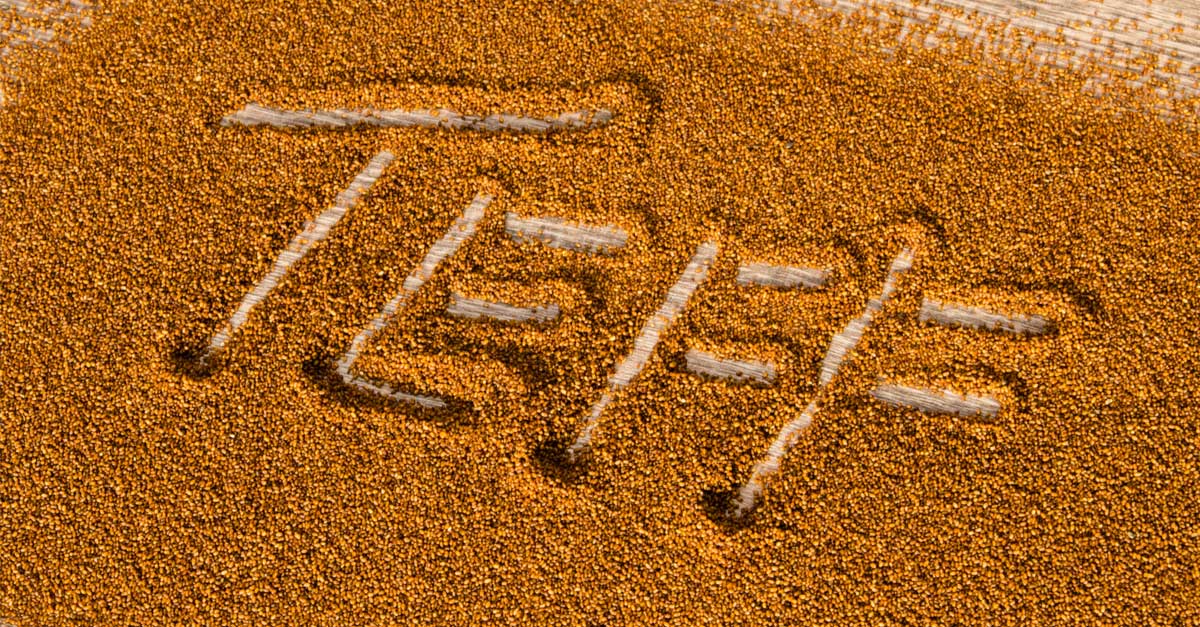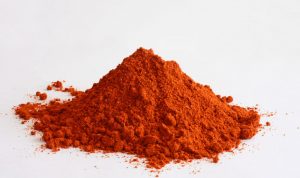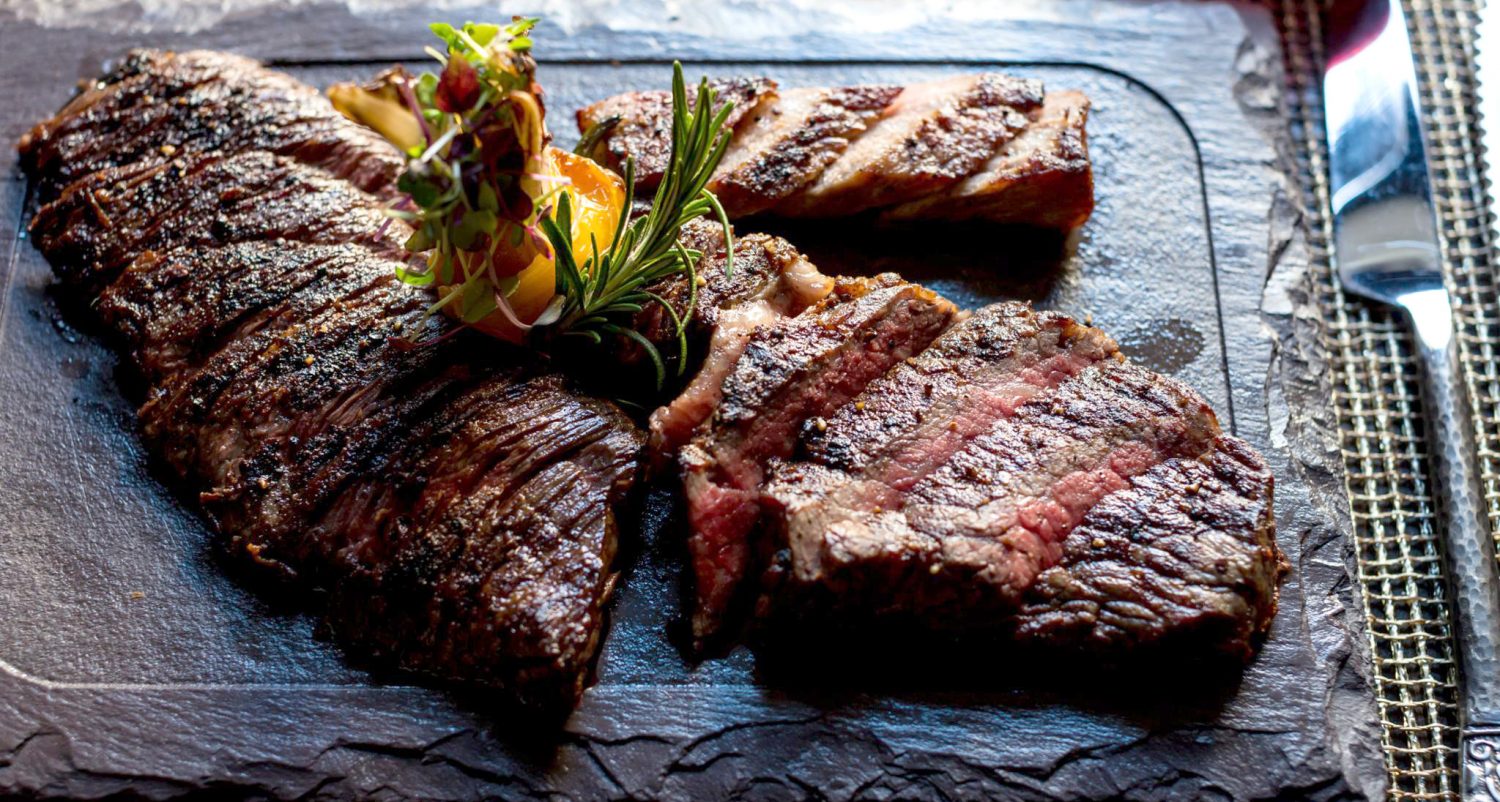
Injera, it is more than just a flatbread to eat with Ethiopian stews.
It doubles as the eating utensil/vehicle. You tear off chunks of this fluffy, pillowy flatbread/pancake and use it to scoop up the stew instead of a knife and a fork or a spoon.
 It is made from what some call one of the super grains, Teff. Following is a quote from a nutritionist on Teff.
It is made from what some call one of the super grains, Teff. Following is a quote from a nutritionist on Teff.
It has more calcium than any other grain, is a complete protein, is the size of a poppy seed, is the only ancient grain (or seed) to contain Vitamin C, is completely gluten and grain-free, and is rich in iron, magnesium, Vitamin B6, fiber, and protein. Meet tef.
On top of it, for a diabetic like me it also has a low glycemic index because what starch it has, which is pretty low to begin with, a third of it is resistant starches; further, it also has plenty of fibre in it to counteract the starches.
Enough pontification, let us talk about Injera.
Injera making is normally a pretty involved process. While it is mostly waiting for it to ferment, it still takes a couple of days, sometimes three in winter. You make a batter of Teff and water with a little bit of salt and wait for it to ferment and get bubbly. I dont tend to have the patience for it or the planning. I tend to say Ethiopian tonight and I need Injera. So I came up with the following quickfire recipe for quick Injera. Tef when it has not had the time to ferment tends to have a grainy texture and so I make a few modifications to making the batter. Also since I am not letting the thing ferment to produce the gases for the fluffy texture, I cheat with Baking powder and Club Soda.
- Cut the Teff flour with a third of Quinoa flour
- Add a little bit of regular AP flour to provide the Gluten to hold the Injera together
- Use Baking Powder and Club Soda
- Fermentation produces a slight sourness that is part of the essence of Injera and Lemon or Lime juices in the batter instead produces a harsh acidity. So I add a pinch or two sumac to the batter that produces a gentler acidity.
Ingredients:
- 2/3 Cup Tef Flour
- 1/3 Cup Quinoa Flour
- 1/4 Cup All Purpose Flour
- 2 Teaspoons Baking powder
- 1-2 Pinches of Sumac
- ~ 1 Cup Club Soda, chilled in the fridge for at least an hour
- 1/2 teaspoon of Kosher salt (adjust for taste)
Directions:
- Sift the Flours, salt, Sumac and the baking powder together to ensure even mixing
- Make a well in the center and pour in the club soda slowly while constantly whisking with a large whisk. Don’t worry, you wont degas it too much
- Add any extra needed club soda to get to the consistency of a thin pancake batter
- Meanwhile heat a non stick skillet (one for which you have a lid, glass lid preferably) over medium low to low heat on the stove
- Pour quarter cup of the batter on to the skillet while holding it tilted slightly away from you and swirl to distribute to a thin layer
- Cover with the lid so the Injera steams. You don’t really want it to brown much like a pancake. You may end up lowering the heat to low to ensure it does not cook too quickly on the bottom
- Injera is done when the top surface appears full of holes and does not look wet
- Take it off the skillet and roll it up to keep it from drying out
- Use up all of the batter
- Wipe dry the inside of the lid to the skillet between uses to remove the condensed moisture so it does not drip back on tot he Injera as it is cooking.
Serve with any of the savoury Ethiopian stews like Doro Wat, Doro Alicha, Key Wat(Beef), Beg Wat(Lamb) or Awaze Tibs (Lamb and Onion).
I actually love Injera with a spicy, sticky Indian curry as well…
Berbere – Ethiopian Spice Mix

There is nothing quite that says Ethiopian food than Berbere, the ubiquitous spice mix of this land. Of course, there isn’t one recipe for Berbere. Every household will have its own variation. This one started with a recipe I got from a colleague of a couple of jobs ago, Abe Woldeselassie. This was his Grand mothers version. As is the norm with handed down spice mixes, even in Ethiopia, I added a couple of minor changes and this is what I have been using to make Doro Wat(Chicken) or Key Wat(Beef). I also love this on roasted Root vegetables (Just toss big chunks in Olive oil with the Berbere and roast them at 375-400 till done and you see some char on them).
Here is my recipe for Berbere.
Ingredients:
- 2 teaspoons coriander seeds
- 1 teaspoon cumin seeds
- ½ teaspoon fenugreek seeds
- 1 teaspoon black peppercorns
- 2 whole allspice berries
- Seeds of 4 green cardamom pods
- 4 cloves
- 5 dried red chilies, seeded, broken into small pieces‡
- 3 tablespoons sweet paprika
- 1 teaspoon salt
- ¼ teaspoon nutmeg
- ½ teaspoon ginger
- ¼ teaspoon cinnamon
- 1 teaspoon turmeric
‡ – You can find giant bags of them for cheap at your local Indian Market. Use them based on your palate. I like mine a little spicy. Use less if you are a “Blandie” 🙂
Directions:
- Using a heavy pan, I like my cast iron pan for this, toast the whole spices, including the chillies, on high heat, shaking the pan regularly to prevent scorching until they are fragrant. This usually takes 2 to 3 minutes.
- Put them in a bowl and let them cool completely.
- Grind the toasted spices fine in a coffee grinder. While the Grandmas and Mothers of Ethiopia used mortars and pestles and elbow grease, a dedicated coffee grinder is perfect and I have moved with “new technology”.
- After grinding the toasted spices fine, add the other spices already in powder form to the grinder and grind everything together for a couple of minutes.
- Store in an airtight container in a dark cabinet or pantry.

